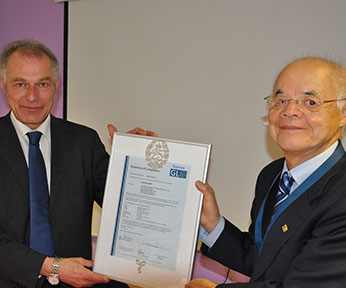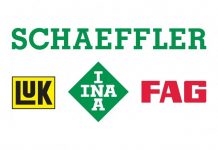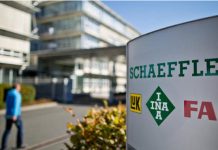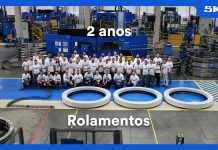With the wind energy industry undergoing rapid expansion, pressure is growing on manufacturers to adhere to global framework policies and standards. The certification of wind turbines and wind turbine components is a crucial requirement in order to export products in different markets, to differentiate them, and for standards to be raised. It is therefore increasingly important for manufacturers to apply for gearbox certification, which requires highly technical engineering knowledge and capability.
Dr. Karl Steingroever (left) presents Dr. Peter Poon, CEO, Romax Technology with 25th Certification
Certification on its own is mainly concerned with safety, not profitability. To design a safe, reliable and profitable gearbox requires a combination of agreed industry rules and standards (certification guidelines) plus proprietary methods from the component designers and manufacturers. As such, it requires highly experienced experts with a broad knowledge of international and national market information, in addition to a deep understanding of the availability of components worldwide and the associated challenges in each field. Gearbox and wind turbine manufacturers going through this process unaided can find it complex and longwinded. For example, the latest level of certification guidelines for wind turbine drivetrains (GL 2012) requires a complete model of the main shaft, gearbox and generator to take into account static and dynamic system interactions.
Standards benchmarked by three to four key global certification bodies also need to be interpreted through experience to ensure a cost competitive product is developed that works. There is great benefit in perfecting this process to reduce time, eliminate design errors, and decrease the risk of data loss between the different stages of drivetrain design process.
A major difference between wind and other industries is the lack of testing. Large components are too expensive to test and even if budgets allowed, actually applying real-world loads to components is extremely difficult and only a handful of test facilities are available worldwide. This increases the risk of a poor design dramatically as there is no “safety net” from comprehensive physical prototyping.
There has been limited industry take-up so far in simulation software capable of bridging this testing gap by adequately modeling the behavior of the wind turbine under different external conditions and different manufacturing tolerances / processes. Romax believes there is an industry need for the adoption of early stage analysis within the design process in order to assist the designer in working through huge numbers of potential design scenarios. Using simulation software packages programmed with intelligent “rule of thumb” parameters, designers can very quickly go through a large number of potential configurations and home in on the optimum solution. Without such tools this optimization and virtual prototyping is simply not possible within the short development times required by the industry.
More importantly, it allows a lot of the risk-reduction work to be done up front, so that issues within the design can be ‘ironed out’ prior to deeper design development (and the large additional costs that come with it).
Optimizing the Process
Engineers must first and foremost always look for ways to optimize drivetrain performance and increase reliability. In particular, engineers must constantly look at ways to solve component failures, reduce costs or speed up development time. Top engineering consultancy firms have managed to reduce gearbox development time by up to six months, through the increase of parametric studies at the concept stage with software, leading to a right first time approach to gearbox design.
For the design and certification process, Romax spends an extensive amount of time looking at the way things work within the drivetrain design and development process, analyzing them, removing bottlenecks and automating tasks where possible. Our engineering knowledge has led to the creation of bespoke software modules, packages and consultancy services to support many industries (including the wind industry) in making the much needed leap from basic design to virtual prototyping.
Best Practice
After painstakingly going through the certification process to perfect it, like many organizations Romax have adopted a best practice solution which looks at improving all aspects of the design, development and analysis of the drivetrain in order to support manufacturers in achieving certification targets.
For the last three years, Romax has solidly worked on developing this best practice, which has resulted in many large scale successful global projects, with a total of 29 gearbox designs in production for wind turbines ranging from 1.5 MW to 6 MW upward, of which 25 (to date) have been awarded GL’s Statement of Compliance to A-Design Assessment Certification. “Looking back over the last five years working with Romax Technology, I can clearly see how Romax has developed in significantly raising the quality of the gearbox designs,” says Dr. K. Steingroever, Germanischer Lloyd (GL). “Spending time and effort putting into place the correct processes to analyze and review the gearboxes allows Romax to continuously develop and become rapid in perfecting design details. This attention to detail has made them very successful in the market, as the only global company to achieve 25 gearbox design A-Level certificates.”
“Through my experience of working with Romax, I find them to be very professional across the globe. We know what we can expect from each other’s organizations and this allows us to achieve certification quickly and efficiently.”
As part of its on-going investment in drivetrain development, Romax utilizes state-of-the-art design and analysis techniques supported by RomaxDesigner for wind, simulation software. RomaxDesigner is the only software certified by Germanischer Lloyd (GL) for gear calculations to design and analyze drivetrains to certification standards. This is supported by its life cycle engineering services including manufacturing assessment and support, technical training, operations and maintenance services and its advanced predictive maintenance tools.
Romax’s recent release of key new products including Concept, CAD Fusion and Dynamic Fusion further highlights the company’s commitment to supporting the principles behind the certification process by enabling a rapid, seamless and lossless workflow for driveline design and development from planning to manufacture.
from Romaxtech
BearingNews















